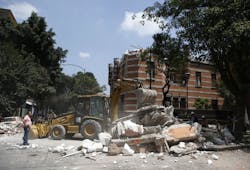The magnitude-7.1 earthquake that hit central Mexico this past Tuesday afternoon has left more than 200 people are dead. It is marked as the worst natural seismic event in the area in more than 30 years.
Geoffrey Abers, a geophysicist at Cornell University who uses the tools of earthquake seismology to understand the forces, material cycles, and deep structure of the Earth, said the proximity of the Cocos plate to large population centers—and all the infrastructure building and development that goes along with it—in the region made Tuesday’s earthquake especially damaging.
Abers stated:
“Like last month’s Oaxaca earthquake, [this] event occurred within a subducting plate—the Cocos plate—after it had started beneath Mexico. Earthquakes within subducting plates are deeper and can reach magnitudes exceeding 8 (like the Oaxaca one), but they are rarer. They also rarely make tsunamis, because they are deep and do not break the sea floor. But they are also more often directly beneath land where people live, so a smaller earthquake can cause significant damage because the earthquake is close. That seems to be the case here. The earthquake was 50 km deep, but the subducting Cocos plate descends very slowly beneath Mexico, so it was close to the largest population centers in Mexico. The effects here are greatly amplified by the geology of Mexico City. The city is built on the bed of a drained lake and the soft sediments there are prone to strong shaking. That was the major cause of damage in the 1985 earthquake, which was centered off the Pacific coast, and seems to be a major cause of damage here. Because these earthquakes are deep in the Earth, we have much less understanding of what controls their maximum size and frequency of occurrence than shallower earthquakes.”
Of concern to the transportation industry is the extent to which these facts may or may not affect the reconstruction and rehabilitation of damaged infrastructure in the quake zone. As of this writing, it remains to be determined the extent of damage that will need to be addressed.
----
Image source: BGR



